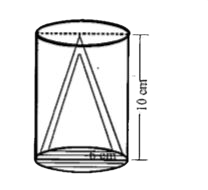In Fig. 16.74, from the top of a solid cone of height 12 cm and base radius 6 cm, a cone of height 4 cm is removed by a plane parallel to the base. Find the total surface area of the remaining solid. (Use π=22/7 and √5=2.236) (FIGURE)
To find the total surface area of the remaining solid after removing a smaller cone from a larger cone, we can follow these steps:
Step 1: Understand the Dimensions
We have a larger cone with:
- Height (H) = 12 cm
- Base radius (R) = 6 cm
A smaller cone is removed from the top with:
- Height (h) = 4 cm
Step 2: Calculate the Height of the Remaining Cone
The height of the remaining cone after removing the smaller cone is:
H′=H−h=12cm−4cm=8cm
Step 3: Find the Radius of the Smaller Cone
Since the smaller cone is similar to the larger cone, we can use the ratio of their dimensions to find the radius (r) of the smaller cone:
rR=hH
Substituting the known values:
r6=412
This simplifies to:
r6=13⟹r=2cm
Step 4: Calculate the Slant Height of the Remaining Cone
The slant height (L) of the remaining cone can be calculated using the Pythagorean theorem:
L=√(H′)2+R2=√(8)2+(6)2=√64+36=√100=10cm
Step 5: Calculate the Total Surface Area of the Remaining Solid
The total surface area (TSA) of the remaining solid consists of:
1. The base area of the larger cone
2. The lateral surface area of the remaining cone
3. The base area of the smaller cone (which is now an open top)
The formula for the total surface area is:
TSA=πR2+πRL+πr2
Substituting the values:
TSA=π(62)+π(6)(10)+π(22)
Calculating each term:
1. π(62)=π(36)
2. π(6)(10)=π(60)
3. π(22)=π(4)
Now, substituting π=227:
TSA=227(36+60+4)=227(100)=22007≈314.29cm2
Final Answer
The total surface area of the remaining solid is approximately 314.29cm2.
---
We have a larger cone with:
- Height (H) = 12 cm
- Base radius (R) = 6 cm
- Height (h) = 4 cm
The height of the remaining cone after removing the smaller cone is:
H′=H−h=12cm−4cm=8cm
Since the smaller cone is similar to the larger cone, we can use the ratio of their dimensions to find the radius (r) of the smaller cone:
rR=hH
Substituting the known values:
r6=412
This simplifies to:
r6=13⟹r=2cm
The slant height (L) of the remaining cone can be calculated using the Pythagorean theorem:
L=√(H′)2+R2=√(8)2+(6)2=√64+36=√100=10cm
The total surface area (TSA) of the remaining solid consists of:
1. The base area of the larger cone
2. The lateral surface area of the remaining cone
3. The base area of the smaller cone (which is now an open top)
TSA=πR2+πRL+πr2
Substituting the values:
TSA=π(62)+π(6)(10)+π(22)
Calculating each term:
1. π(62)=π(36)
2. π(6)(10)=π(60)
3. π(22)=π(4)
TSA=227(36+60+4)=227(100)=22007≈314.29cm2
The total surface area of the remaining solid is approximately 314.29cm2.
Topper's Solved these Questions
Similar Questions
A cone of same height and same base radius is cut from a cylinder of height 8 cm and base radius 6 cm .Find the total surface area and volume of the remaining solid.
View SolutionFrom a solid cylinder of height 4cm and radius 3cm a conical cavity of height 4cm of base radius 3cm is hollowed out. What is the total surface area of the remaining solid?
View Solution
Knowledge Check
From a solid cylinder of height 10 cm and radius of the base 6 cm, a cone of same height and same base is removed. The volume of the remaining solid is :
A240π cu. cmB5280 cu. cmC620π cu. cmD360π cu. cm
A cone of equal height and equal base is cut off from a cylinder of height 24 cm and base radius 7 cm .Find the total surface and volume of remaining solid.
View SolutionFind the curved surface area of a cone whose height is 12cm and base radius is 5cm ?
View SolutionFrom a solid right circular cylinder with height 10 cm and radius of the base 6 cm, a right circular cone of the same height and base is removed. Find the volume of the remaining solid. (Take π=3.14)
View SolutionFrom a solid circular cylinder with height 12 cm and radius of the base 5 cm, a right circular cone of the same height and the same base radius is removed find the volume and total surface area of the remaing solid . [User π=3.14]
View SolutionFrom a right circular cylinder with height 10cm and radius of base 6cm, a right circular cone of the same height and base is removed. Find the volume of the remaining solid.
View SolutionFrom a solid cylinder whose height is 8 cm and radius 6cm , a conical cavity of height 8 cm and of base radius 6 cm is hollowed out . Find the volume of the remaining solid.Also find the total surface area of the reamining solid.[ Take π=3.14 ]
View SolutionFrom a solid right circular cylinder with height 10 cm and radius of the base 6 cm, a right circular cone of the the same height and same base is removed . find the volume of the remaining solid

View Solution
